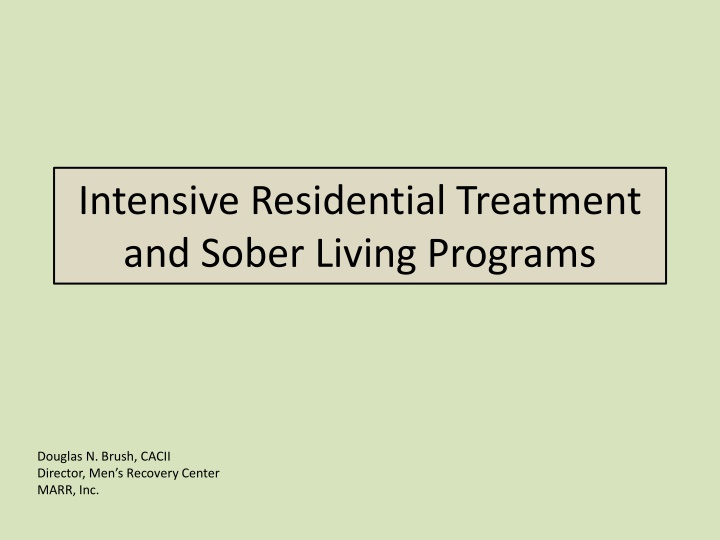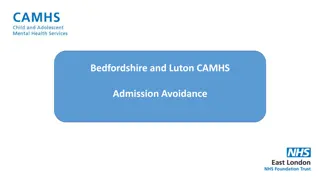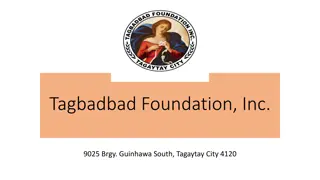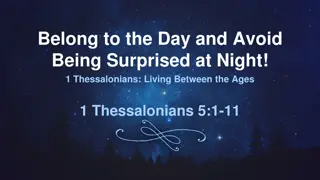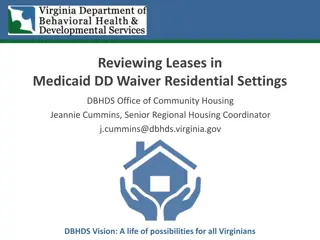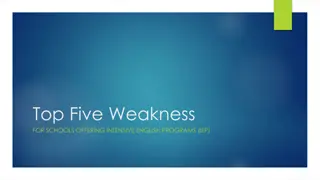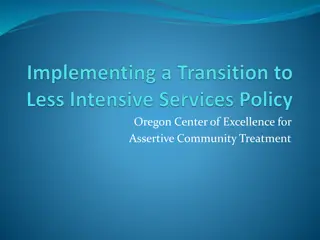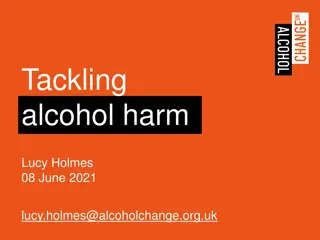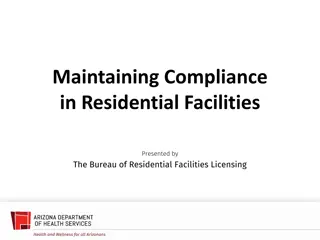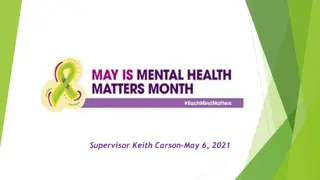Comprehensive Intensive Residential Treatment and Sober Living Programs at MARR, Inc.
MARR, Inc. offers comprehensive intensive residential treatment and sober living programs for individuals struggling with substance abuse. With a focus on gender-specific care, intensive clinical services, and family recovery support, the program aims to address core issues, promote accountability, and develop essential recovery skills for a fresh start. The first days at MARR involve thorough assessments, orientation, and introduction to the therapeutic community. Group therapy plays a vital role in bonding patients to treatment, enhancing outcomes and promoting sobriety.
Download Presentation

Please find below an Image/Link to download the presentation.
The content on the website is provided AS IS for your information and personal use only. It may not be sold, licensed, or shared on other websites without obtaining consent from the author.If you encounter any issues during the download, it is possible that the publisher has removed the file from their server.
You are allowed to download the files provided on this website for personal or commercial use, subject to the condition that they are used lawfully. All files are the property of their respective owners.
The content on the website is provided AS IS for your information and personal use only. It may not be sold, licensed, or shared on other websites without obtaining consent from the author.
E N D
Presentation Transcript
Intensive Residential Treatment and Sober Living Programs Douglas N. Brush, CACII Director, Men s Recovery Center MARR, Inc.
MARR Components of Care Abstinence based Minimum 90-day intensive residential structure Gender separate, gender specific Intensive clinical services Comprehensive medical services Family Recovery Services 12 Step focused spirituality and recovery principals Therapeutic Community as the agent of change Comprehensive/intensive residential treatment with a recovery experience
Primary Criteria for Admission 18 years old or older Voluntary admission Primary diagnosis is substance abuse or chemical dependence Co-occurring Psychiatric disorders are mild to moderate Medically stable
Goals for Intensive Residential Treatment To assess medical and clinical needs of each client To identify core issues for treatment To identify and learn to express feelings To confront denial and dishonest behaviors To develop trust and accountability within the Therapeutic Community To develop foundational recovery skills To assist the client to become willing to experience a new way of living (hope)
First Day at MARR Medical screening/clearance Nursing assessment Full history and physical Psychiatric and addiction assessment (within 1st three days) Orientation of rules and expectations of the residential and intensive day program Begin work on Psychosocial History to be reviewed by Primary Counselor Introduction into the Therapeutic Community Orientation of family members with family therapist
Group, Group, and More Group Group therapy and addiction treatment are natural allies. One reason is that people who abuse substances are often more likely to stay sober and committed to abstinence when treatment is provided in groups, apparently because of rewarding and therapeutic benefits like affiliation, confrontation, support, gratification and identification. This capacity of group therapy to bond patients to treatment is an important asset because the greater the amount, quality, and duration of treatment, the better the client s prognosis (Leshner 1997, Project MATCH Research Group 1997).
Phase I: Intensive Day Treatment Attending 30 hours of groups per week in day treatment Attending 3 hours of groups per week in Therapeutic Community Attending 3 hours of professional peer groups per week for physicians, nurses, dentists, pharmacists, PAs, pilots, lawyers and other business professionals Attending 6 12 step meetings weekly
Feelings School: Intensive Day Treatment Groups Morning Spiritual Life Story/First Step Inventory Life Story presented between day 15 and 25 First Step Inventory presented between day 25 and 35 First Step Education 12 Step Education Medical Education Family Dynamics Life Skills Relapse Prevention Anger Management Trauma Education Group Therapy Primary Group Weekend Planning/Weekend Wrap-up Mentoring Disordered Eating Track (Women s Program) Body Image (Women s Program) DBT Group (Women s Program) Yoga (Men and Women s Program)
Groups that Drive the Phase I Process Life Story Presentation Preparing and reading your life story allows an intentional opportunity for you to grasp the significance of your personal history and to give it coherence. First Step Inventory The first step inventory is a documentation of the control the disease has exerted over your life. Unlike a life story, the inventory focuses on your behavior and its consequences.
Therapeutic Community Introduction into the therapeutic community Presentation of contract within 3 weeks Accountability to self and others 3 groups/week focused on building trust and relationships Participating in weekly chores and expectations Eating meals together Grocery shopping Maintaining a clean recovery home-like setting Community meal and life-story Participation in 12 step and spiritual recovery as a community
Completion of Phase I: Intensive Day Treatment Completion of: Life Story First step inventory 2nd and 3rd step assignments Relapse prevention plan Phase I review Selecting and beginning work with a sponsor is a condition of completion of Phase I Average length of stay in Phase I 35-45 days
Additional Services Provided During Phases I and II Medical and psychiatric management and follow-up Medication supervision Random Urine Drug Screening Family support services
Transition to Phase II 7-10 Groups per week Continued focus on trust and accountability within the therapeutic community Mirror Image group and mirror image placement for professionals Work phase for non-professionals Transition from mentoring group to aftercare groups Aftercare groups offered in Phase II include Anger Management Thinking About Your Thinking Building Better Relationships Introductory Trauma Therapy Process Group Therapy Individual therapy added Continued work on core issues identified in Phase I Participation in 3-day family workshop Family and couples therapy as recommended Continued attendance at 6 12 step meetings per week and working the steps with a sponsor
Work Phase for Non-professionals Begin looking for part-time employment Morning spiritual life and check-in group Reporting to Residential Managers on progress and job search activities Attending Feelings School (Day Treatment Groups) when not at work Work must not interfere with community meetings and aftercare groups
Completion of Phase II Average stay in Phase II is 60 days 60 Day Review within community Phase II Review with clinical team Discussion of progress Review of Relapse Prevention Plan Development of Aftercare Plan Discussion of transition to home or recommendation to extended residential care Therapeutic leave to home to establish recovery and aftercare contacts Family involvement Professional Program involvement Joining the Alumni Association Goodbye Process
Length of Stay in Intensive Residential Program Length of Stay for Graduates of Intensive Residential Program Non-professionals Number of Days Non-Professionals Number of Days Average 82.4 Average 102.2 Minimum 1 Minimum 90 Maximum 123 Maximum 123 Standard Deviation 36.1 Standard Deviation 16.0 Professionals Number of Days Professionals Number of Days Average 93.1 Average 102.7 Minimum 1 Minimum 88 Maximum 155 Maximum 155 Standard Deviation 29.2 Standard Deviation 14.3
Completion Rate for Intensive Residential Program in 2014 Non-professionals n=42 Professionals n=26 70% 87% Percent of Graduates Transitioning to Extended Residential Program in 2014 Non-professionals n=31 Professionals n=7 78% 27%
Resources for Residential Levels of Care Georgia Association of Recovery Residences (G.A.R.R.) was established in 1987 to create, monitor and improve standards and measures of quality for recovery residences in the state of Georgia. (www.garrnow.org) National Alliance for Recovery Residences (NARR) was founded in 2011 to support persons in recovery by improving their access to quality recovery residences through standards, support services, placement, education, research and advocacy. (www.narronline.org)
